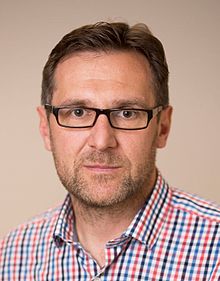Christian G. Hartinger FRSNZ (born 1974) is an Austrian-born New Zealand bioinorganic chemist known for his work in metal-based anticancer drugs. In 2022 he was elected a Fellow of the Royal Society Te Apārangi.
Christian Hartinger | |
|---|---|
 Christian Hartinger | |
| Born | 1974 (age 49–50) Vienna, Austria |
| Nationality | Austrian |
| Alma mater | University of Vienna (MSc, 1999; PhD, 2001; Habilitation, 2009) |
| Known for | |
| Awards | New Zealand Institute of Chemistry Maurice Wilkins Centre Prize |
| Scientific career | |
| Fields | Chemistry |
| Institutions | University of Auckland |
| Doctoral advisor | Bernhard Keppler |
| Website | hartinger |
Scientific career
editHartinger studied chemistry at the University of Vienna, earning his MSc in 1999 and his PhD in 2001 under Bernhard Keppler. He was an Erwin Schrödinger Fellow with Paul Dyson at the École Polytechnique Fédérale de Lausanne from 2006 to 2008 and obtained his habilitation at the University of Vienna in 2009. In 2011, Hartinger was appointed the position of associate professor at Waipapa Taumata Rau, where he currently serves and in 2015 was promoted to professor.
Hartinger's research interests are in bioinorganic chemistry, medicinal chemistry, and bioanalytical chemistry, where he uses an interdisciplinary approach in drug discovery. He is specially interested in the development of metal-centred anticancer agents, particularly ruthenium anticancer drugs, and using analytical methods to characterise their behaviour in the presence of biomolecules.[1]
Hartinger has now published over 169 publications and has an h-index of 69.[2]
In 2022 Hartinger was elected a Fellow of the Royal Society Te Apārangi. The society said his "innovative approaches have established new directions in metallodrug research, and his developed methodologies continue to have far-reaching impact in the community. His findings challenge paradigms about the reactivity of metal compounds towards biomolecules and thereby inform the design of novel biomaterials".[3]
Distinctions/honours
edit| Year | Distinction/honour | Organisation |
|---|---|---|
| 2005 | Theodor Körner Prize | Theodor Körner Fund |
| 2006 | Erwin Schrödinger Fellowship | Austrian Science Fund |
| 2009 | Best Paper Award for the publication "Modifying the Structure of Dinuclear Ruthenium Complexes with Antitumor Activity"[4] | Applied Organometallic Chemistry |
| 2010 | Innovative Teaching Award | Bank Austria |
| Visiting Professor | Chimie ParisTech, France | |
| 2011 | Carl Duisberg Memorial Prize | German Chemical Society |
| 2013 | Visiting Professor | University of Vienna |
| 2014 | Scientific Organizing Committee Co-chair | 7th International Symposium on Bioorganometallic Chemistry |
| 2016 | Chair of the 8th Asian Biological Inorganic Chemistry Conference | 8th Asian Biological Inorganic Chemistry (AsBIC) Conference |
| 2016 | SBIC Early Career Award 2016 | Society of Biological Inorganic Chemistry |
| 2016 | New Zealand Institute of Chemistry Maurice Wilkins Centre Prize | Maurice Wilkins Centre |
| 2017 | Hood Fellowship (Cambridge, UK) | The University of Auckland Foundation |
| 2017 | Hill Tinsley Medal | New Zealand Association of Scientists |
Selected research outputs
edit- Meier, S. M.; Novak, M. S.; Kandioller, W.; Jakupec, M. A.; Roller, A.; Keppler, B. K.; Hartinger, C. G., Aqueous chemistry and antiproliferative activity of a pyrone-based phosphoramidate Ru(arene) anticancer agent. Dalton Trans, 2014, 43 (26), 9851–9855
- Meier, S. M.; Babak, M. V.; Keppler, B. K.; Hartinger, C. G., Efficiently detecting metallodrug-protein adducts: ion trap versus time-of-flight mass analyzers. ChemMedChem, 2014, 9 (7), 1351–1355
- Hartinger, C. G.; Groessl, M.; Meier, S. M.; Casini, A.; Dyson, P. J., Application of mass spectrometric techniques to delineate the modes-of-action of anticancer metallodrugs. Chem Soc Rev, 2013, 42 (14), 6186–6199
- Meier, S. M.; Novak, M.; Kandioller, W.; Jakupec, M. A.; Arion, V. B.; Metzler-Nolte, N.; Keppler, B. K.; Hartinger, C. G., Identification of the structural determinants for anticancer activity of a ruthenium arene peptide conjugate. Chem Eur J, 2013, 19 (28), 9297–9307
- Kandioller, W.; Balsano, E.; Meier, S. M.; Jungwirth, U.; Göschl S.; Roller, A.; Jakupec, M. A.; Berger, W.; Keppler, B. K.; Hartinger, C. G., Organometallic anticancer complexes of lapachol: metal centre-dependent formation of reactive oxygen species and correlation with cytotoxicity. Chem Commun, 2013, 49 (32), 3348–3350
- Meier, S. M.; Hanif, M.; Pichler, V.; Novak, M.; Jirkovsky, E.; Jakupec, M. A.; Davey, C. A.; Keppler, B. K.; Hartinger, C. G., Novel metal(II) arene 2-pyridinecarbothioamides: A rationale to orally active organometallic anticancer agents. Chem Sci, 2013, 4 (4), 1837–1846
- Babak, M. V.; Meier, S. M.; Legin, A. A.; Adib Razavi, M. S.; Roller, A.; Jakupec, M. A.; Keppler, B. K.; Hartinger, C. G., Am(m)ines make the difference: organoruthenium am(m)ine complexes and their chemistry in anticancer drug development. Chemistry, 2013, 19 (13), 4308–4318
- Kurzwernhart, A.; Kandioller, W.; Bächler S.; Bartel, C.; Martic, S.; Buczkowska, M.; Mühlgassner, G.; Jakupec, M. A.; Kraatz, H.; Berdnarski, P. J.; Arion, V. B.; Markos, D.; Keppler, B. K.; Hartinger, C. G., Structure-activity relationships of targeted RuII(η6-p-cymene) anticancer complexes with flavonol-derived ligands. J Med Chem, 2012, 55 (23), 10512-10522
References
edit- ^ Jakupec, M. A.; Galanski, M.; Arion, V. B.; Hartinger, C. G. & Keppler, B. K. (2008). "Antitumour metal compounds: more than theme and variations". Dalton Transactions (2): 183–194. doi:10.1039/b712656p. PMID 18097483.
- ^ "Christian Hartinger's Google Scholar profile". Retrieved 10 March 2017.[permanent dead link]
- ^ "Researchers and scholars at the top of their fields elected as Fellows". Royal Society Te Apārangi. Retrieved 18 March 2022.
- ^ Mendoza-Ferri, M. G.; Hartinger, C. G.; Alexey, A. A.; Kandioller, W.; Severin, K. & Keppler, B. K. (2008). "Modifying the Structure of Dinuclear Ruthenium Complexes with Antitumor Activity". Applied Organometallic Chemistry. 22 (6): 326–332. doi:10.1002/aoc.1394.